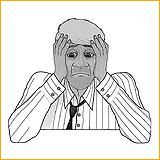| Mental Health Tips | |
| Common Mental Problems | |
| Substance Misuse | |
| Treatment of Mental Disorders | |
| Mental Health Education Pamphlets | |
 Generalized anxiety disorder and Phobic disorders
Generalized anxiety disorder and Phobic disorders
(Special thanks to Dr. William Chui of Institute of Mental Health, Castle Peak Hospital, for authoring this article)
Generalized anxiety disorder and phobic disorders are characterized by highly distressing and excessive worry and anticipation of impending danger. Apart from psychological symptoms, there are physiological symptoms, e.g. fast heart beat, fast breathing etc. Some level of anxiety is experienced by everyone every day, and everyone finds certain things particular stressful to them. How anxious is too anxious? Is there any effective treatment for someone who is too anxious? Correction understanding about anxiety disorders can get rid of the unnecessary anxiety about the illness. This is the essential step of overcoming anxiety disorder.
1. How common are anxiety disorders?
2. How anxious is too anxious?
3. What are the major features of an anxiety disorder?
4. What are the causes of anxiety disorder?
5. How generalized anxiety disorder is different from phobic disorder?
6. What are the major types of phobic disorders?
7. What are the treatment of generalized anxiety disorders and phobic disorders?
1. How common are anxiety disorders?
Anxiety disorders include a wide range of disorders, including generalized anxiety disorder, phobic disorders, panic disorder, obsessive compulsive disorders, post traumatic stress disorders, etc. Anxiety disorders are very common. Up to 20% of people might have one anxiety disorder at some time of their life. Female to male ratio is about 2 to 1.
2. How anxious is too anxious?
Everyone experiences some level of anxiety every day. Anxiety and fear are natural response to a potential threat. Actually, the ability to fear is essential to the survival of human in the world. The uncomfortable nature of “anxiety experience” makes it an effective tool for us to avoid danger. However, when anxiety is excessive, it becomes highly uncomfortable and badly affects our functioning. To decide if the anxiety is too much, we have to see if the level of functioning is impaired by the anxiety. The relationship between performance and anxiety level takes an inverted U shape; moderate level of anxiety improves performance; performance drops with high level of anxiety. Therefore, when your anxiety level impairs your performance and causes significant distress, your anxiety is excessive. The duration, intensity and circumstances for the excessive anxiety vary widely among different forms of anxiety disorders.

3. What are the major features of an anxiety disorder?
There are 2 major features of an anxiety disorder: 1. In terms of “thought”, there is a highly distressing and excessive worry and anticipation of impending danger with little chance to escape; 2. Physiological symptoms, e.g. fast heart beat, fast breathing, chest and abdominal discomfort, muscle tension, dry mouth, and sweating, etc.
4. What are the causes of anxiety disorder?
Genetic and environmental factors are both involved. A family history of anxiety disorder, traumatic experience in childhood, heightened anxiety in parents, stressful life events, and insufficient coping strategies, etc all contribute to the risk of anxiety disorders.
5. How generalized anxiety disorder is different from phobic disorder?
Abnormal anxiety takes two major patterns. The first pattern is a generalized, free-floating anxiety which does not happen in episodes or associated with a specific situation, but lasts for days and months, running in a milder severity, related to a wide range of normal daily events e.g. work and school performance, personal responsibilities, etc. A person with generalized anxiety disorder experiences a generalized free-floating anxiety. The patient has excessive worry on trivia, difficulty to control such worry, and is apprehensive for most days over a period of 6 months.
The patient also has symptoms, like restlessness, easy fatigue, difficulty concentrating, irritability, muscle tension and sleep disturbance (difficulty falling or staying asleep).
The other pattern of abnormal anxiety is episodic anxiety which takes an abrupt onset and discrete episodes. It appears in different time or situation, or it can happen without particular triggers. It tends to be more intense than the free-floating form of anxiety. This kind of episodic anxiety is experienced in phobic disorders and panic disorder.
Phobic disorders presents with episodic anxiety which is associated with specific feared situation or objects. (In comparison, another kind of anxiety disorder, known as panic disorder, presents with episode anxiety which are not restricted to any particular situation (i.e. unpredictable); please see the article “Panic disorder” for further details).
6. What are the major types of phobic disorders?
By the situation which triggers the anxiety, there are three types of phobic disorders are agoraphobia, social phobia and specific phobia. A common feature of different phobic disorders is that the feared situations or objects are avoided or endured with intense distress and anxiety.
A person with agoraphobia fear entering crowded places where immediate escape is difficult, e.g. bus, train, elevators. Because of such fear, the person might only leave home with the company of another trusted person. In severe cases, the person might not be able to leave home at all. It is common for a person to have both agoraphobia and panic disorder, because a person with panic attack easily has fear of being in a crowded place where he cannot escape in case of having a panic attack.
A person with social phobia fears social situation in which the person is exposed to unfamiliar people or possible scrutiny by others. The person fears that he will act in an embarrassing way. Although the person recognizes the anxiety is excessive or unreasonable, exposure to the feared social situation invariably provokes anxiety. These social situations can be isolated events, e.g. speaking public, or almost all social activities outside home.
Specific phobias are restricted to clearly specific objects or situations, other than those in agoraphobia and social phobia. Examples of these objects are height, darkness, blood, needles, animal or insects.
7. What are the treatment of generalized anxiety disorders and phobic disorders?
Both pharmacological and psychological treatment are effective.
Selective Serotonin Reuptake Inhibitors (SSRI) and Serotonin and Noradrenaline Reuptake Inhibitors (SNRI) are effective in treating generalized anxiety disorder and phobic disorders. Serotonin and noradrenaline are the two major chemicals involved in the control of emotion which involves anxiety. Because it takes 2 to 4 weeks for the medications to bring out symptoms improvement, at the beginning of treatment, the patient might still have much distress from the symptoms. Some patients might have exacerbation of anxiety symptoms at the beginning of treatment (usually the first 4 to 7 days); however, such discomfort usually subsides afterward.
Tranquilizers can immediately relieve anxiety. However, there is a risk of dependence. Use of tranquilizer should be limited to short-term use and only in severe anxiety.
Psychological treatments, particularly cognitive behavioural therapy, are effective alone and augment the effect of medication treatment. Since avoidance of the feared situation is the core feature of phobic disorders, an important part of psychological treatment of phobic disorder is gradual exposure to the feared situation, e.g. first imaging the feared situation, and then gradually to real life exposure.
It is important to remember that receiving psychological treatment is not a passive process. Receiving psychological treatment is more like working in a gym with a fitness coach; the coach instructs and motivates you to complete various programmes of training. All in all, it is you giving the courage, determination and perseverance to finish what you are instructed and motivated to do. In psychological treatment, all treatment effect comes from your effort to overcome the avoidance of the feared situation and adopt new way of thinking. Nobody can replace yourself.
Websites with relevant information / Reference
|
================================================================================ Thank you for browsing the mental health tips on the IMH internet. We would like to hear feedback from you through the questionnaire below. Your comments are most welcome for our continuous improvement. |
No. of visitors of this page: 5575


